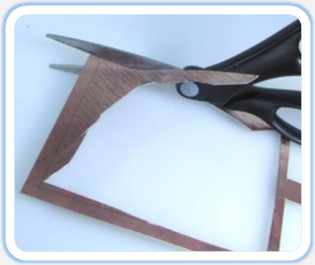Constructing A Transparent Electrode
As stated previously, the transparent discharge plate is constructed from three main components; a 4" x 5" piece of glass with a transparent conductive tin oxide coating on one side, a rectangle ring electrode made from thin (.032) copper sheeting and a .005 thick piece of transparent plastic. See figure below.


To make a small 4" x 5" transparent electrode, purchase the 4 x 5" tin oxide glass. When you receive the glass, be careful. The edges of the glass are sharp. It will be impossible to tell visually which side of the glass has the conductive tin oxide coating.
So, to determine the tin oxide coating side of the glass you need an ohmmeter. Inexpensive VOM's (volt-ohm-meters) are available from local electrical store. Set the VOM to read OHMS on maximum (highest) resistance setting. Bring both probes in contact with one side of the transparent electrode material. The side with the conductive coating will deflect the meter, see figure to left. The meter shown to the left is on its lowest resistance setting and is showing a resistance of 165 ohms per inch.

The ring electrode should be made from a thin conductive material. My ring electrode is made from single sided copper clad board that is only .031 thick. You can easily cut this material with a scissors. You may substitute the ring electrode material I used with something comparable, like a thin copper (or steel, tin) sheet (or thick aluminum foil, etc).

The outside dimension of the ring electrode is cut to the same size as the tin oxide glass, with a tab running off on one end. Next, cut away the inside of the ring electrode material, leaving a ½" border, this makes a rectangular ring electrode.

Before securing the ring electrode to the tin oxide glass, clean the ring electrode thoroughly so you have a good surface for the silver epoxy.
Mix the silver epoxy according to directions, see picture below. The mixed epoxy color is gray and will have the consistancy of paste. Apply an even coating completely around the copper side of the board. Next place the transparent electrode, conductive side facing the copper clad side of the ring electrode on top of the ring electrode. Place a book or flat object onto the transparent electrode to hold the assembly tight and together while the epoxy cures.

One peculiarity of the silver epoxy is that it needs a gentle heat treating to become conductive and form a good bondbetween the copper and tin oxide glass. To do this, I used an incandescent table lamp with a 40 watt bulb. I kept the lamp approximately 6" away from the assembly for 2-4 hours. The glass under the table lamp should feel warm (not hot) to the touch.

Test assembly with an ohmmeter before proceeding. Touch the tab of the ring electrode with one probe and touch the tin oxide coating with the other. You should show good conductivity (low resistance).
Next, solder a foot or so of high voltage wire to the protruding tab. This will connect the transparent discharge plate to the HV source when you are finished.

Since the conductive coating of the transparent electrode is delicate we need to protect it. Purchase a sheet of transparent plastic which is approximately .005 thick. Cut the plastic sheet to the size of the transparent electrode. Lay the plastic on top of the conductive tin oxide coating.
Use black electrical tape secured to and ran along the edges of the transparent electrode to secure the plastic sheet (see Figure above). The tape serves a dual purpose. First it secures the plastic sheet to the transparent electrode. Second it provides insulation along the edge of the electrode where it is needed. You may want to double tape the corner edges to provide an additional measure of insulation.

4" x 5" Tin Oxide Glass (Glass has sharp edges) $25.00
5 x 7" .031 thick on-sided copper clad board $2.50
Silver Epoxy $40.00
Finished 4" x 5" Transparent discharge plate $129.95
Silver Epoxy is available from Mouser Electronics.
Mouser Electronics, Inc.
1000 North Main Street
Mansfield, TX 76063
(800) 346-6873
Local: (619) 449-2222
Fax: (619) 449-6041
www.mouser.com
Mouser Part #: 5168-2400
Manufacturer Part #: CW2400
Manufacturer: Chemtronics
Description: .25OZ SILVER EPOXY
